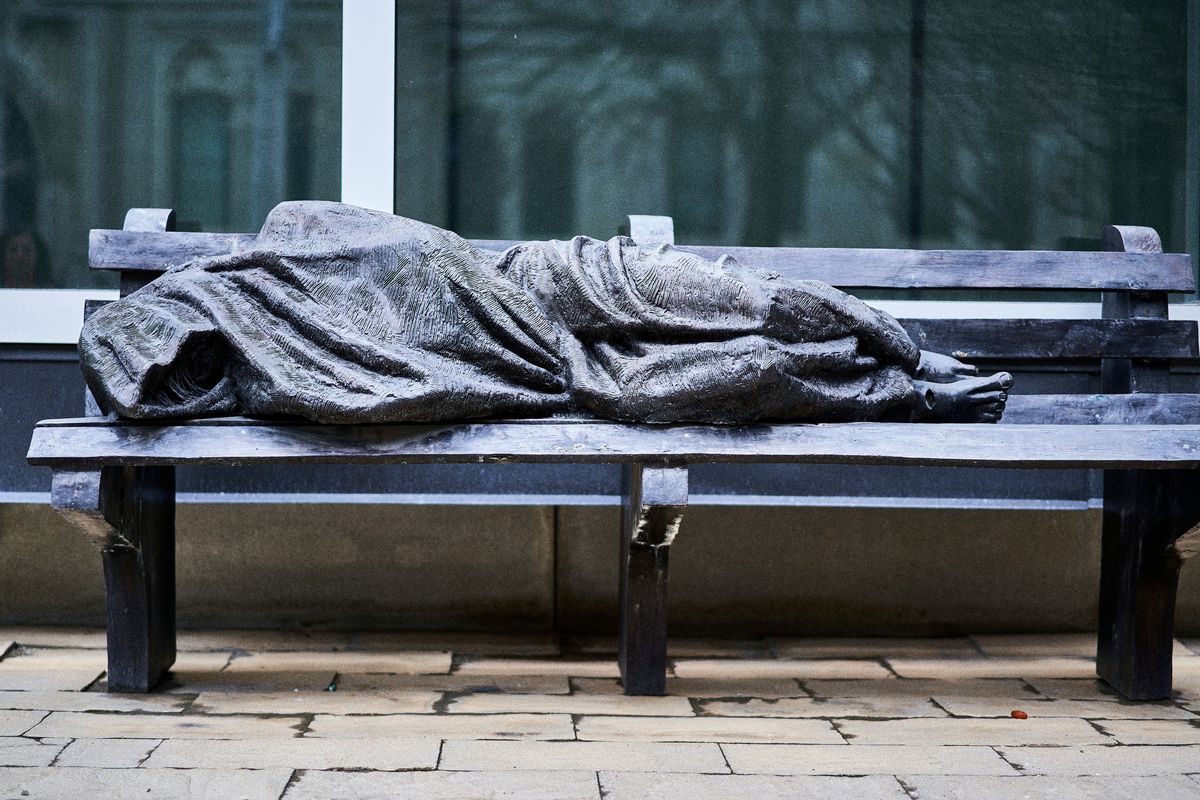From adding spikes to removing benches, anti-homeless architecture hurts us all
These "solutions" to homelessness issues are making things worse.

"HOMELESS JESUS" by sculptor Timothy P. Schmalz in Toronto, Canada
Have you noticed it's getting harder and harder to find a place to sit in public spaces these days? There's a reason for that. It's a purposeful choice many municipalities are making in an effort to keep people who are homeless from setting up camp or making beds out of benches.
The anti-homeless spikes that make lying down on steps, along buildings and on other flat surfaces have been addressed by communities in creative ways, such as the artists who set up a cozy bed with a bookshelf attached to it over one set of spikes in London. But there are other manifestations of hostile architecture popping up around the world as the homelessness crisis reaches dire proportions in some cities.
Hostile or anti-homeless architecture makes the environment incompatible with comfortable rest and relaxation, which serves the purpose of pushing homeless people out of those spaces (but does nothing to actually solve the problem). And at the same time, it makes shared public spaces a lot less comfortable for everyone.
Cash Jordan shared a bunch of examples of hostile architecture in New York City, from bumpy subway vent covers that prevent people from sleeping on them, to slanted benches you can just lean on but not sit on, to removing benches and seats from public transportation stations altogether.
Not only do such choices make life harder for homeless people, but people with disabilities, elderly and pregnant people and others need to be able to sit for a bit when they're out and about. And all of us could use a little respite from walking and standing sometimes. Hostile architecture choices remove features that make public spaces accessible and usable for us all.
Watch Jordan explain:
"It seems to me the 'hostile architecture' is only kicking the can down the road— if you notice they are not solving their homeless crisis—just keeping people out of certain areas," wrote one commenter.
"That's not stopping people from being homelesss, that's just making everyone uncomfortable," wrote another.
"Cities/people think homeless people will just go away with things like this. Unless you've been homeless (I have) you don't understand the desperation, fear, and embarrassment of it. Whether due to poor choices or not (and it's NOT always, even in America), no one deserves this," shared another.
"As someone with a disability that makes it very painful for me to stand for long periods, that train station would be absolute hell," added another. "So not only is this affecting the homeless population, it affects the many, many people like me with disabilities. I don’t like having to take my wheelchair places if I can help it, but places like that would force me to."
Homelessness is not a simple problem to solve, no matter what anyone says, but putting money into something like this, which doesn't actually address the problem itself, is wasteful in addition to making public spaces less usable. What if we invested that money into quality, affordable housing, programs that address the addiction and mental health issues that often perpetuate homelessness or other initiatives that actually stand a chance of solving the problem at its core instead?
Targeting the homeless population with hostile architecture is unkind at its core, and making public spaces uninviting, unwelcoming and uncomfortable for all is a short-sighted "fix" that doesn't actually help anyone. Let's take a step back, reset our moral compass and create spaces that are useful, accessible and comfortable for all.



 In a 4-day model, kids often (but not always) receive less instructional time. Photo by
In a 4-day model, kids often (but not always) receive less instructional time. Photo by 


 A woman looking at her phone on the toilet.via
A woman looking at her phone on the toilet.via  A man looking at his phone on the toilet.via
A man looking at his phone on the toilet.via 